3 MIN READ
Tar Spot Spray Timing Trials
August 22, 2021
Trial Objective
Every year since first reported in the United States in 2015, regions of tar spot incidence have expanded. Tar spot has been repeatedly identified in counties where it has been previously reported and continues to expand to nearby counties every year. In 2020, tar spot expanded into new areas that included Missouri, Minnesota, Pennsylvania, and Ontario (Figure 1).
In severe cases, losses from tar spot of 50 bushels per acre or more have been observed.1
While fungicides have shown effectiveness in managing tar spot, timing of fungicide applications is important in successfully managing this disease.
The objective of these trials was to determine the effectiveness of fungicide rate and timing on the management of tar spot in corn.
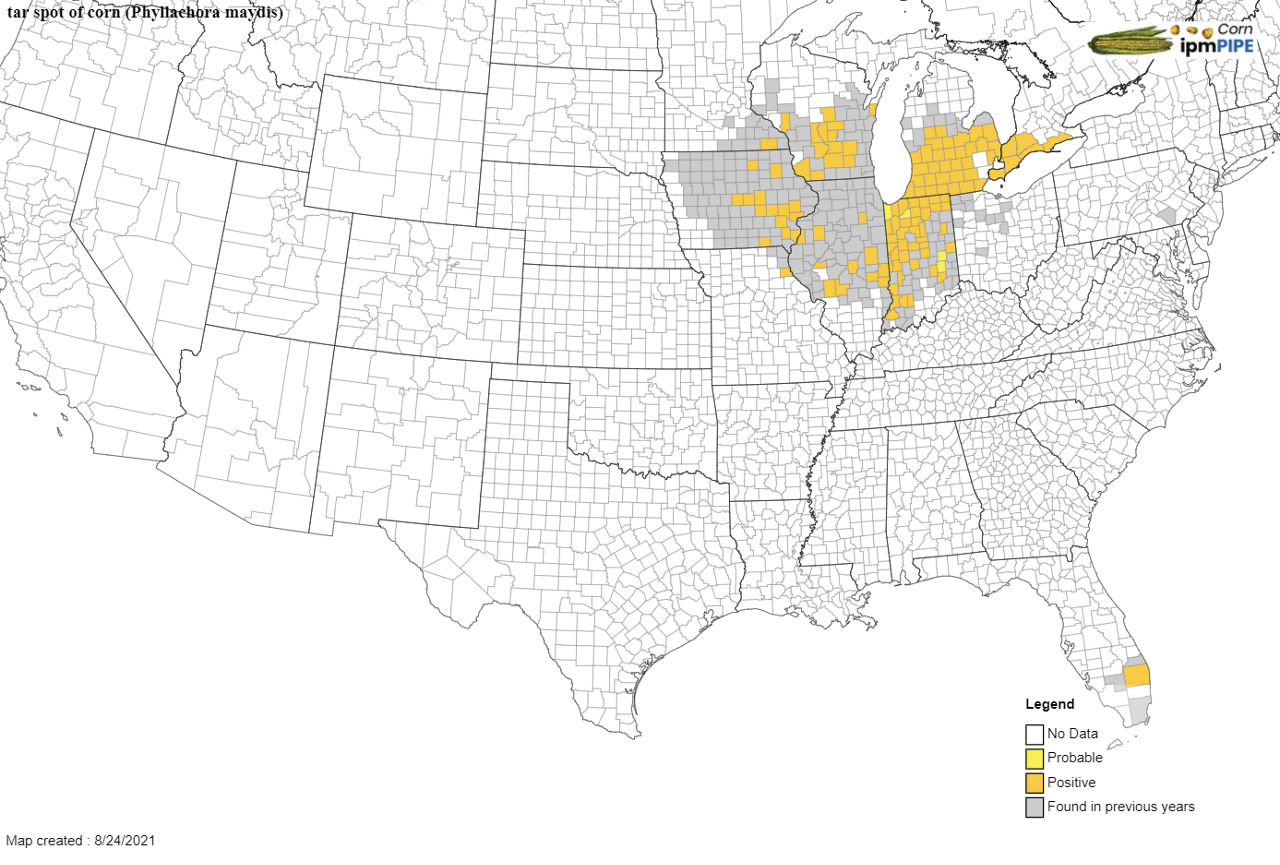
Research Details: Click on a location site to review data
Research Site Details
2020 University of Illinois Trial (Monmouth, IL)
- For this trial, fungicide treatments were applied at the R3 growth stage.
- Treatments included:
- Nontreated control
- Affiance® Fungicide
- Aproach® Fungicide
- Aproach® Prima Fungicide 2.34 SC
- Delaro® 325 SC fungicide
- Miravis® Neo Fungicide
- Proline® 480 SC fungicide
- Revytek™ Fungicide
- Trivapro® Fungicide
- Delaro® Complete Fungicide
- Veltyma™ Fungicide
- Aproach + TILT® fungicide
- Tilt® 3.6 EC fungicide
- Lucento® Fungicide
- Affiance® Fungicide + Badge® SC Fungicide
- Domark® 230 ME Fungicide +Badge® SC Fungicide
- Disease severity was visually rated as the percent leaf area infected from the ear leaf of five plants located within the center two rows of each plot on September 7 (R5) and September 15.
- Tar spot developed rapidly increasing from 9.9% on September 7 to 25.3% on September 15.
Understanding the Results
2020 University of Illinois Trial
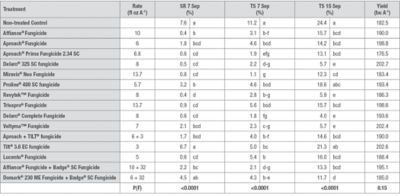
All fungicides tested in this trial reduced tar spot severity relative to non-treated controls at both rating dates.
No differences in average yield were detected, which may have been a result of a severe wind event in August that caused some leaning and lodged corn that increased variability in the trial.
Research Site Details
2019 University of Illinois Trial (Monmouth, IL)
- For this trial, fungicide treatments were applied at the R5 growth stage.
- Treatments included:
- Nontreated control
- Aproach® fungicide
- Delaro® 325 SC fungicide
- Miravis ® Neo fungicide
- Tilt® fungicide
- The growing season in 2019 was challenging, with early season rains delaying planting, followed by hot, drought conditions from VT through approximately R3.
- Cooler, wetter weather in early September favored tar spot development late in the season, within a week of treatment applications.
2019 University of Illinois Trial
Understanding the Results

All fungicides tested in this trial reduced tar spot severity and plant senescence relative to non-treated controls on four weeks after application (October 3, 2019).
Delaro® 325 SC fungicide (8 fl oz), Miravis® Neo Fungicide (13.7 fl oz) and TILT® fungicide (2 fl oz) reduced tar spot severity significantly more than Aproach® fungicide (6 fl oz) four weeks after application.
Miravis® Neo Fungicide (13.7 fl oz) provided the greatest reduction in plant senescence.
No significant differences in lodging or yield were detected between fungicide treatments.
Research Site Details
Effect of Tar Spot in Central Indiana Trial, 2020 (West Lafayette, IN)
- For this trial, fungicide treatments were applied at the V7 and VT/R1 growth stages.
- Treatments included:
- Nontreated Control
- Trivapro® 2.21 SE Fungicide
- Aproach® Prima 2.34 SC Fungicide
- Delaro® Complete Fungicide
- Veltyma™ 3.34 S Fungicide
- Miravis® Neo 2.5 SE Fungicide
- Tar spot stroma visually assessed percentage (0-100%) of leaf area on five plants in each plot at the ear leaf (EL).
- Tar spot chlorotic and necrotic symptoms visually assessed percentage (0-100%) of leaf area on five plants in each plot at the EL.
Understanding the Results

For this trial, all fungicide treatments tested reduced tar spot symptoms on all leaves assessed. All fungicide treatments increased percent green over nontreated control.
There were no significant differences between treatments for percent lodging, harvest moisture, test weight and average corn yield.
Research Site Details
2020 Tar Spot Strip Trial
- This trial included eight locations.
- 7606 Early Relative Maturity Set:
- DKC49-72RIB Brand Blend, Susceptible*
- DKC52-34RIB Brand Blend, Less Susceptible*
- 7606 Mid Relative Maturity Set:
- DKC63-21RIB Brand Blend, Susceptible*
- DKC64-87RIB Brand Blend, Less Susceptible*
- This trial included two fungicide treatment blocks:
- Delaro® 325 SC Fungicide
- Delaro® Complete Fungicide (tank mix of Delaro 325 SC Fungicide + Luna® Privilege Fungicide)
- Spray treatments for each block of chemistry included:
- Unsprayed
- V5-V7 growth stage, application of Delaro® 325 SC Fungicide (6 oz/acre)
- V5-V7 growth stage, application of Delaro® 325 SC Fungicide (6 oz/acre) followed by R1 growth stage application of Delaro® Complete Fungicide.
- R1 growth stage, application of Delaro® Complete Fungicide.
- R1 growth stage, application of Delaro® Complete Fungicide tank-mix followed by R3-R4 growth stage application of Delaro® Complete Fungicide.
Understanding the Results
2020 Tar Spot Fungicide Timing Strip Trial
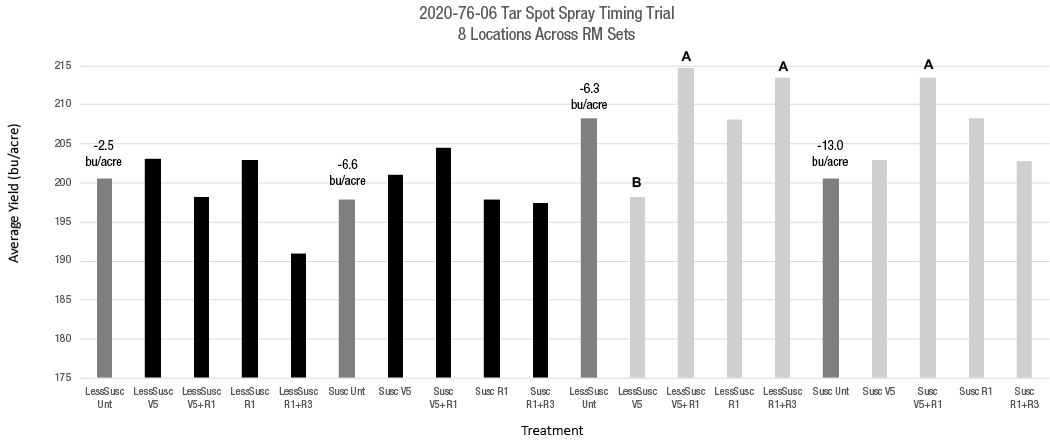
Average yield reported across all eight locations with yield reported.
Fungicide treatments did not have a large effect on harvest moisture although moisture was significant at only 0.4% point wetter for the R1+R3 or V5+R1 treatment timings compared to untreated.
In 2020, most spray timings in this trial responded better than the untreated control in a year with low severity and widespread drought stress later in the season in areas of previous tar spot incidence.
In this trial, Delaro® Complete (Delaro® 325 SC fungicide + Luna® Privilege Fungicide) had a higher yield response across all locations and treatments.
Research Site Details
2019 Tar Spot Fungicide Timing Strip Trial
- This trial included twelve locations.
- 7604Early Relative Maturity Set:
- DKC49-72RIB Brand Blend, Susceptible*
- DKC52-34RIB Brand Blend, Less Susceptible*
- 7604 Mid Relative Maturity Set:
- DKC63-21RIB Brand Blend, Susceptible*
- DKC64-87RIB Brand Blend, Less Susceptible*
- This trial included two fungicide application timings:
- Untreated control
- V5 growth stage
- R1 growth stage
- V5 + R1 growth stage
- R1 + R3 growth stage
Understanding the Results
2019 Tar Spot Fungicide Timing Strip Trial
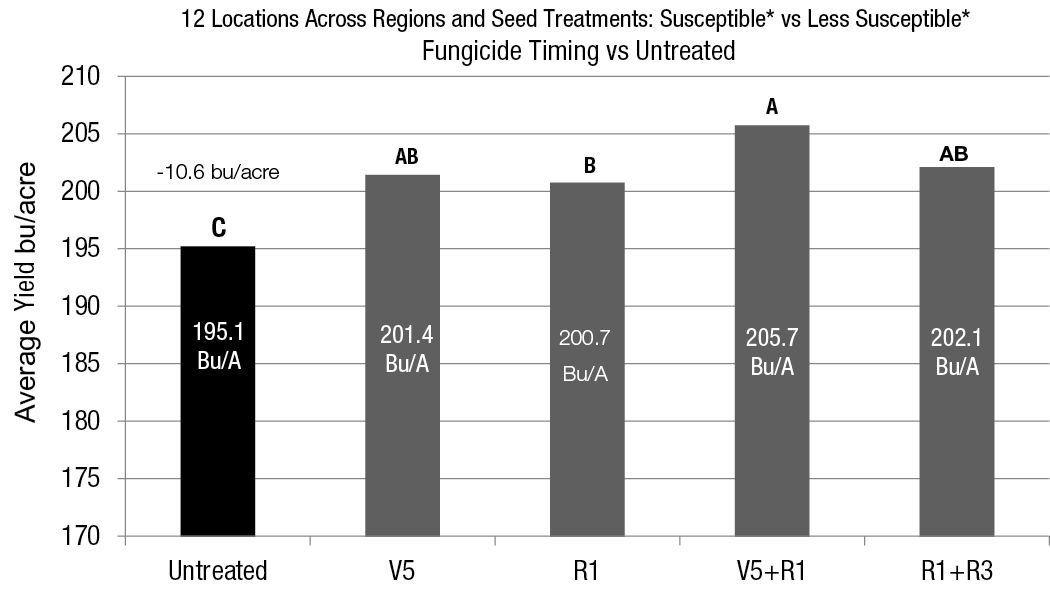
Average yield reported across all eight locations with yield reported.
Fungicide treatments did not have a large effect on harvest moisture although moisture was significant at only 0.4% point wetter for the R1+R3 or V5+R1 treatment timings compared to untreated.
In 2020, most spray timings in this trial responded better than the untreated control in a year with low severity and widespread drought stress later in the season in areas of previous tar spot incidence.
In this trial, Delaro® Complete (Delaro® 325 SC fungicide + Luna® Privilege Fungicide) had a higher yield response across all locations and treatments.
Research Site Details
2018 Michigan State University Tar Spot Fungicide Trial (Ganges, MI)2
- For this trial, fungicide treatments were applied at the R3 growth stage on August 10, 2018.
- Treatments included:
- Nontreated control
- Headline® 2.09 SC fungicide
- Proline® 480 SC fungicide
- Delaro® 325 SC fungicide
Tar spot disease severity was determined by estimating the percent leaf area with lesions on the ear leaf and ear leaf+2 (second leaf above the ear leaf) from 10 plants in the center two rows (five from each row) at 14 days after treatment (August 24) and 28 days after treatment (September 7).
Tar spot was first noted in the field by the farmer on July 8, 2018. Disease was widespread throughout the field and found on every plant on Aug 10, 2018. Severe lodging was developing in areas of the field by September 7, 2018.
Understanding the Results

- Initial ratings of the non-treated plots on August 10, 2018, found an average of 1.2% and 0.7% disease severity on the ear leaf and ear leaf+2, respectively. Disease severity rapidly increased over the next four weeks, with lesions essentially occupying the entire leaf of non-treated plots by September 7, 2018.
Proline® fungicide and Delaro® 325 SC fungicide both significantly reduced foliar disease on the ear leaf and ear leaf+2 at the September 7, 2018, rating.
Research Site Details
2018 Wisconsin Foliar Fungicide Trial (Arlington, WI)3
- Two 109-day relative maturity (RM) brown midrib (BMR) corn products were used.
- Treatments included:
- Nontreated control
- Proline® 480 SC fungicide applied at R1 and R2 growth stages
- Delaro® 325 SC fungicide applied at R1 and R2 growth stages
- Headline® AMP fungicide applied at R1 and R2 growth stages
- Miravis® Neo fungicide applied at R1 and R2 growth stages
- Miravis® Ace fungicide applied at R1 growth stage
- Topguard® fungicide applied at R1 growth stage
- Lucento® fungicide applied at R1 growth stage
Tar spot severity was visually assessed as the average symptomatic percentage of ear leaves for five plants per plot with the aid of a standard area diagram; means for each plot were used in the analysis.
Understanding the Results
2018 Wisconsin Foliar Fungicide Trial3
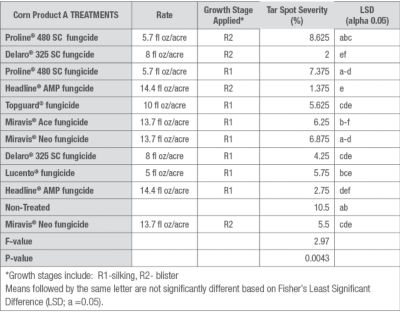
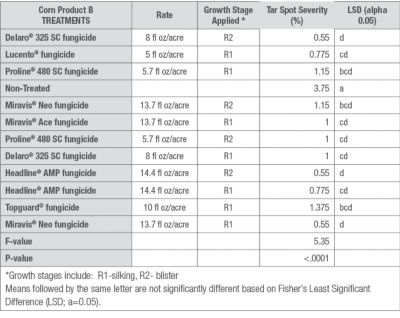
- Tar spot severity was significantly impacted by fungicide treatments (Table 1). Most treatments resulted in lower tar spot severity compared to not treating.
Key Learnings
Across years, application of a high quality, multiple mode of action fungicide such as Delaro® Complete Fungicide helped to protect yield potential against tar spot compared to the untreated control.
Timing of fungicide application is critical based on when disease pressure occurs.
Early and continuous scouting in areas with previously reported disease is important for understanding disease pressure and planning timely fungicide applications if needed.
Depending on when disease pressure occurs (early- to mid-season or later in the season), multiple fungicide sprays may be warranted.
*All corn products show susceptibility to tar spot. Those considered susceptible show more severe symptoms of tar spot earlier than those considered less susceptible.
Sources:
1 Chilvers, M. July 1, 2020. Tar spot in the spotlight. Michigan State University Extension. https://www.canr.msu.edu/news/tar-spot-in-the-spotlight.
2Chilvers MI, McCoy AM, Byrne AM, Cornett H, Chang X, Noel ZA, Koeman S. 2018. Effect of fungicide on the management of tar spot of corn in Michigan. Plant disease management reports 13:CF016. Michigan State University.
3Reed H, Mueller B, Groves CL, Smith DL. July 26, 2021. Impact of foliar fungicides on disease and silage quality of brown midrib (BMR) corn hybrids in Wisconsin. Plant Health Reports. https://doi.org/10.1094/PHP-02-21-0019-RS.
Websites verified 08/24/2021.
6005_R12